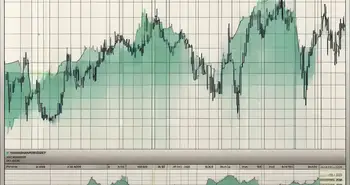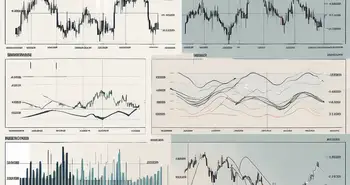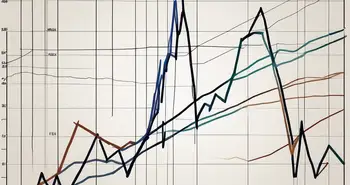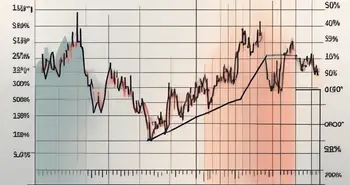Understanding the Commodity Channel Index: What Is It and How Does It Work?

In the dynamic world of trading, having a reliable indicator that can help you navigate the markets is essential. One such tool that has gained popularity among traders is the Commodity Channel Index, or CCI. Understanding what the CCI is and how it works can provide you with valuable insights into market trends and potential trading opportunities.
Defining the Commodity Channel Index (CCI)
The Commodity Channel Index (CCI) is a widely used technical analysis indicator that was developed by Donald Lambert in 1980. Its primary function is to measure the current price level relative to its historical average. Traders and investors utilize the CCI to identify overbought and oversold conditions in the market, as well as potential trend reversals or continuations.
Originally designed for commodities trading, the CCI has gained popularity and expanded its application to other financial markets, including stocks, bonds, and currencies. Its versatility and effectiveness have made it a valuable tool for market participants across various asset classes.
The Origin and Purpose of CCI
The Commodity Channel Index was initially created to cater specifically to commodities traders. The name itself reflects its original purpose. However, as its effectiveness became evident, traders and analysts started using it in different markets to gauge the price levels of various assets.
The main objective of the CCI is to provide traders with a quantitative tool that helps determine whether an asset is priced too high or too low relative to its historical average. By identifying overbought and oversold conditions, the CCI assists traders in making informed decisions regarding potential market entry or exit points.
Moreover, the CCI can also indicate potential trend reversals or continuations. By analyzing the CCI values in conjunction with other technical indicators or chart patterns, traders can gain insights into the potential direction of the market and adjust their strategies accordingly.
Key Components of the CCI
The Commodity Channel Index is calculated using a specific formula that incorporates three key components: the typical price, the simple moving average (SMA), and the mean deviation.
The typical price is calculated as the average of the high, low, and closing prices for a given period. This value represents the average price level of the asset during that period.
The simple moving average (SMA) is the average of the typical prices over a specified number of periods. It smooths out the price data and provides a clearer picture of the overall trend.
The mean deviation measures the average distance between each typical price and the SMA. It quantifies the volatility or dispersion of the asset's price from its average.
By combining these components, the CCI generates a numerical value that oscillates above and below a zero line. Positive CCI values indicate that the price is above its average, suggesting an overbought condition. Conversely, negative CCI values indicate that the price is below its average, suggesting an oversold condition.
Traders often use specific thresholds to interpret CCI values. For example, a CCI value above +100 may indicate an extremely overbought condition, while a value below -100 may suggest an extremely oversold condition. These thresholds can vary depending on the asset being analyzed and the trader's individual strategy.
It is worth noting that the CCI is a lagging indicator, meaning it relies on past price data to generate signals. Therefore, it is essential to use the CCI in conjunction with other technical analysis tools and consider other factors such as market fundamentals and news events to make well-informed trading decisions.
The Mechanics of the Commodity Channel Index
Now that we have covered the basics of the CCI, let's delve into the mechanics of how it is calculated and interpreted.
Calculating the CCI
To calculate the CCI, you first need to determine the number of periods you want to consider. This can range from a few days to several months, depending on your trading style and preferences. Once you have chosen the number of periods, follow these steps:
- Calculate the typical price for each period by taking the average of the high, low, and closing prices.
- Calculate the simple moving average (SMA) by summing the typical prices over the specified number of periods and dividing by that number.
- Calculate the mean deviation by summing the absolute differences between each typical price and the SMA, and dividing by the number of periods.
- Divide the difference between the current typical price and the SMA by the mean deviation.
- Multiply the result by a constant factor that is typically 0.015, but can be adjusted according to market conditions and personal preferences.
The final number obtained is the CCI value for that particular period. Repeat this calculation for each subsequent period to obtain a series of CCI values.
Interpreting CCI Values
Once you have calculated the CCI values, it's time to interpret them. As mentioned earlier, positive values indicate an overbought condition, while negative values indicate an oversold condition. However, it is important to note that extreme CCI values alone are not sufficient to make trading decisions.
Traders often use additional indicators or confirmation signals to validate their CCI analysis. For example, a trader might wait for the CCI to cross above the zero line after reaching an oversold level before considering a long position. Conversely, a trader might wait for the CCI to cross below the zero line after reaching an overbought level before considering a short position.
By combining the CCI with other technical analysis tools, such as trend lines, moving averages, or support and resistance levels, traders can increase their probability of success and make more informed trading decisions.
The Role of CCI in Trading Strategies
Now that we have a good understanding of how the CCI works, let's explore its applications in trading strategies.
Identifying Overbought and Oversold Conditions
One of the main uses of the CCI is to identify overbought and oversold conditions in the market. When the CCI reaches extreme levels, it suggests that the price has deviated significantly from its average, and a potential reversal or correction may be imminent.
Traders often use the CCI in combination with other oscillators, such as the Relative Strength Index (RSI) or the Stochastic Oscillator, to confirm overbought or oversold conditions. By waiting for multiple indicators to align, traders can increase the accuracy of their trading signals and reduce the likelihood of false signals.
Spotting Divergences with CCI
Another valuable application of the CCI is in spotting divergences between price and the indicator itself. Divergences occur when the price forms a higher high or a lower low, while the CCI fails to confirm the move with a corresponding higher high or lower low.
These divergences can indicate potential trend reversals or continuations. For example, a bullish divergence occurs when the price forms a lower low, but the CCI forms a higher low. This suggests that despite the temporary downward move in price, the selling pressure is weakening, and a potential reversal to the upside may be in the cards.
Limitations and Risks of Using CCI
While the CCI can be a useful tool in a trader's arsenal, it is essential to understand its limitations and associated risks.
False Signals and Market Volatility
Like any technical indicator, the CCI is not infallible and can generate false signals. These false signals can occur in highly volatile markets or during periods of consolidation, where prices fluctuate within a narrow range.
It is crucial to use the CCI in conjunction with other indicators or technical analysis tools to confirm trading signals and reduce the likelihood of false alarms. Additionally, placing proper stop-loss orders and managing risk is essential to protect your capital in case the market moves against your position.
The Importance of Supplemental Indicators
While the CCI provides valuable insights into overbought and oversold conditions, it should not be relied upon as the sole indicator for trading decisions. Markets are complex, and multiple factors can influence price movements.
Traders should consider using supplementary indicators, such as moving averages, trend lines, or volume analysis, to validate CCI signals and gain a more comprehensive understanding of the market dynamics. By combining multiple indicators, traders can enhance their trading approach and improve their overall success rate.
Enhancing Your Trading Approach with CCI
Now that we have explored the mechanics and applications of the CCI, let's discuss how you can enhance your trading approach by incorporating the CCI into your strategy.
Combining CCI with Other Technical Indicators
One way to enhance your trading approach is to combine the CCI with other technical indicators that complement its strengths and weaknesses. For example, you might consider using the CCI in conjunction with a trend-following indicator, such as the Moving Average Convergence Divergence (MACD), to identify potential trend reversals or continuations.
By waiting for the CCI to cross above or below the zero line in conjunction with a moving average crossover on the MACD, traders can increase the probability of successful trades and avoid false signals.
Adapting CCI to Different Market Conditions
Another way to enhance your trading approach with the CCI is to adapt its parameters to different market conditions. As market volatility fluctuates, what may be considered an overbought or oversold condition in one market may not hold true in another.
By adjusting the number of periods or the constant factor in the CCI calculation, traders can adapt the indicator to the current market environment. This flexibility allows traders to fine-tune their approach and increase the accuracy of their trading signals.
Personally, I've had great success incorporating the CCI into my trading strategy. By combining it with other indicators such as the RSI and MACD, I've been able to identify high-probability trading opportunities and make informed decisions with confidence. The CCI has become an integral part of my trading toolkit, and I could not imagine trading without it.
FAQs
What is the Commodity Channel Index (CCI) and how does it work?
The Commodity Channel Index (CCI) is a technical analysis indicator that measures the current price level relative to its historical average. It helps identify overbought and oversold conditions, as well as potential trend reversals or continuations. The CCI is calculated using the typical price, simple moving average (SMA), and mean deviation. Positive values suggest an overbought condition, while negative values suggest an oversold condition.
How do I calculate the CCI?
To calculate the CCI, you need to determine the number of periods you want to consider and follow these steps:
- Calculate the typical price for each period.
- Calculate the simple moving average (SMA).
- Calculate the mean deviation.
- Divide the difference between the current typical price and the SMA by the mean deviation.
- Multiply the result by the constant factor.
The final number obtained is the CCI value for that particular period.
How do I interpret CCI values?
CCI values can be interpreted as follows:
- Positive values indicate an overbought condition.
- Negative values indicate an oversold condition.
- Extreme values alone are not sufficient to make trading decisions; additional confirmation signals are often used.
What are the limitations and risks of using CCI?
Some limitations and risks associated with using CCI include:
- False signals can occur, especially in volatile markets or during periods of consolidation.
- CCI should not be relied upon as the sole indicator for trading decisions; supplementary indicators should be used.
How can I enhance my trading approach with CCI?
You can enhance your trading approach with CCI by:
- Combining CCI with other technical indicators that complement its strengths and weaknesses.
- Adapting CCI parameters to different market conditions by adjusting the number of periods or the constant factor in the calculation.
Do you have any personal advice or story about CCI?
Early in my trading career, I struggled to find a reliable indicator that could help me identify overbought and oversold conditions effectively. That's when I came across the Commodity Channel Index (CCI). As I started incorporating the CCI into my trading strategy, I noticed a significant improvement in my trading results.
One particular trade stands out in my memory. The CCI had reached an extreme oversold condition, suggesting a potential reversal was on the horizon. I combined this signal with a bullish divergence on the chart, and it turned out to be a winning trade. It was a defining moment for me, as it highlighted the power of the CCI and its ability to capture profitable trading opportunities.
Since then, the CCI has become an integral part of my trading approach, and I continue to use it in conjunction with other indicators to make informed trading decisions. The key lesson I learned from my experience is the importance of patience and confirmation when using the CCI. By waiting for multiple signals to align, traders can increase their odds of success and avoid falling victim to false signals.
Ready to take your trading to the next level with the insights you've gained from the Commodity Channel Index (CCI)? Discover Morpher, the revolutionary trading platform that's changing the game. With Morpher, you can trade a vast array of markets from stocks to sneakers, all with zero fees, infinite liquidity, and the safety of a non-custodial wallet. Whether you're looking to start small with fractional investing or amplify your trades with up to 10x leverage, Morpher caters to your every need. Experience the future of trading built on the Ethereum Blockchain and get ahead with a platform designed for investors like you. Sign Up and Get Your Free Sign Up Bonus today, and join the community of traders who are shaping the world of investing with Morpher.

Disclaimer: All investments involve risk, and the past performance of a security, industry, sector, market, financial product, trading strategy, or individual’s trading does not guarantee future results or returns. Investors are fully responsible for any investment decisions they make. Such decisions should be based solely on an evaluation of their financial circumstances, investment objectives, risk tolerance, and liquidity needs. This post does not constitute investment advice.

Painless trading for everyone
Hundreds of markets all in one place - Apple, Bitcoin, Gold, Watches, NFTs, Sneakers and so much more.

Painless trading for everyone
Hundreds of markets all in one place - Apple, Bitcoin, Gold, Watches, NFTs, Sneakers and so much more.









